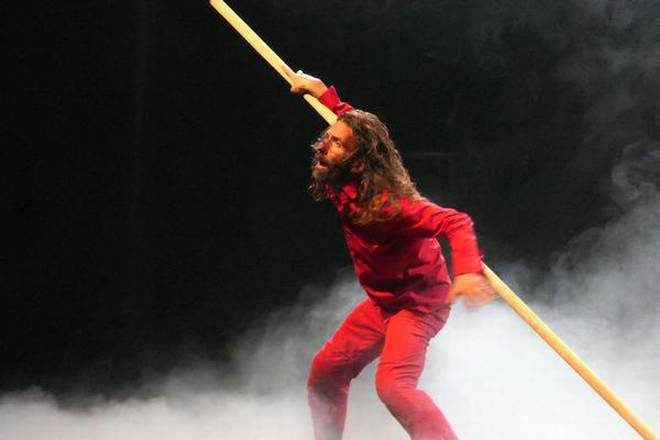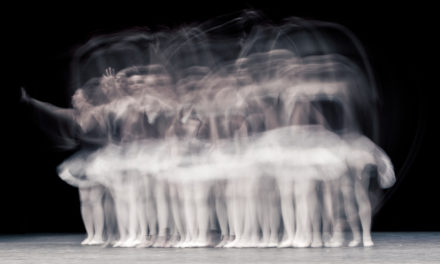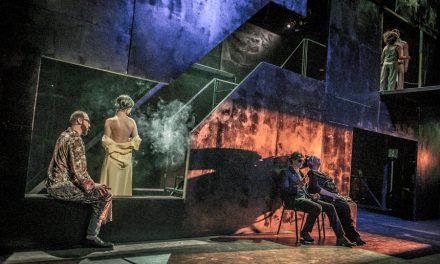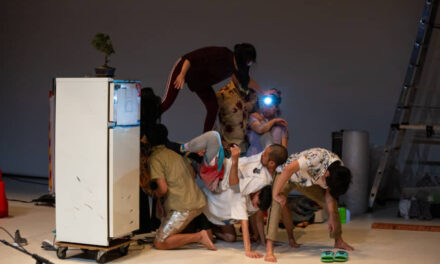Focusing on varied issues, three foreign plays staged at the 8th Theatre Olympics appealed with their presentation and performance.
The Last One presented by Gema Galiana and Anthony Nikolchev’s The Useless Room, U.S., is a fine theatrical piece in terms of innovative presentational style as well as a severe indictment of mindless exploitation of nature in the name of development.
Directed by Galiana and written by Nikolchev, there are three characters—one woman and two men. It is a physical theatre involving a lot of violent encounters between performers who appear to be trained in martial art and adept at the use of violence against the co-actor in a way not to hurt him or her grievously. The men fight among themselves to grab more and more space and the woman desperately tries to thwart their acts of destruction. The men throw on the woman heaps of sand. One male becomes immobile while clutching a ladder. They live in a world characterized by a dog eats dog approach.
There are some bricks kept at different places on the stage and sands. Some ladders are also kept. Buckets tied to chains keep on swinging in different directions from time to time. There is a mask of the head of an animal with horns which suggests a buffalo. This image metaphorically indicates that in the name of development the beauty of nature with its flora and fauna is being destroyed. Initially, the offstage sounds, the chirping of birds provide the audience sweet aural experience but as the destruction continues these sweet sounds disappear. The mask of a buffalo head suggests that with the arrival of white settlers, the craze for hunting American buffalo began as a dangerous sport.
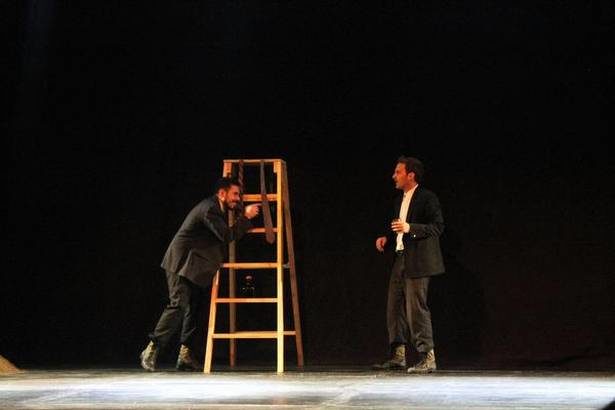
The aim of the production is not to build well-defined characters but to project situations with minimal words rich in metaphoric meanings.
Galiana as woman personifies the wounded nature to protect herself from greedy reckless exploiters. Julian Sandoval as Man 1 and Anthony Nikolchev as Man 2 represent forces of destruction engaged in a fight to the finish for monopolizing the productive forces and exploiting them to the hilt.
Multi-layered work
Dziady-NOC Druga written and directed by Piotr Tomaszuk and staged by Teatr Wierszalin, Poland in Polish appears to be a ritualistic theatre on the surface but it turns out to be a multi-layered artwork. Slowly and slowly it reveals dramatis personae—some are evil spirits and some freedom fighters who are resurrected after they died in the prison. It is an intensely gripping show and “a requiem for the martyrs” of freedom, and a source of inspiration for enslaved people.
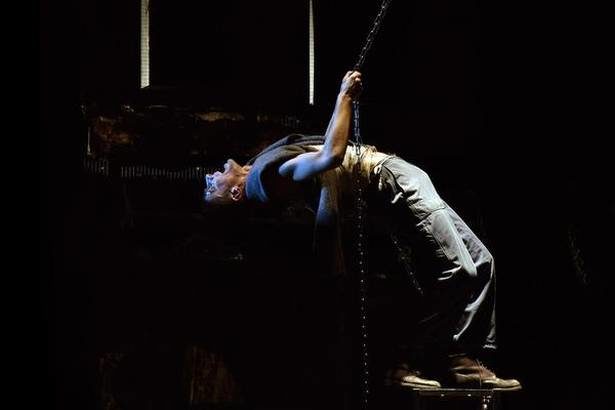
A scene Dziady-NOC Druga
It is set in the 1920s when Poland and Lithuania were under the occupation of Russia. Those who tried to break the shackles of slavery were put behind bars. Physical torture and inhuman jail conditions caused their death.
The design, highly subtle lighting, props, and music create a mysterious atmosphere. As the rituals begin, the ghosts start assembling. The ghost of a poet remains stuck between the sky and earth. Evil spirits also visit the assembly. A priest is called to pacify the evil spirits. The rituals infuse power into the dead who recall their torturous life in the prison of Tsar. Among these spirits, there is the spirit of a poet who challenges God. In the dark shadows and the mysterious rituals the spirit of poet prophecies that the ultimate victory will be that of freedom fighters over their oppressors.
The device of evoking the dead souls through ritualistic theatre is dramatically effective enough to transcend language barriers.
“Physiological” style
Attends, Attends, Attends written and directed by Jan Fabre and presented by Troubleyn/Jan Fabre from Belgium featuring Cẽdric Charron as a solo performer was watched with excitement and admiration.
The play is based on the Greek mythology that focuses on Charon who is a ferryman carrying the souls of the dead across a river. What is noteworthy about the production is the evocation of a sense magic on the stage with the device of smoke, music, and lighting. Solo performer Cẽdric Charron as a ferryman roving fast across the river with all his strength gives the illusion of floating of boat between the earth and sky, the ferryman tightly holding oar.
It is the acting technique that makes this production uniquely distinct from conventional style of acting. The actor calls it “physiological” style that demands maximum body stress and intense concentration on the character. As Cẽdric Charron took a curtain call he received thunderous applause. His costume was drenched with sweat that indicates the amount of stress he has exerted to internalize his mythological character.
This article originally appeared in The Hindu on April 13, 2018, and has been reposted with permission.
This post was written by the author in their personal capacity.The opinions expressed in this article are the author’s own and do not reflect the view of The Theatre Times, their staff or collaborators.
This post was written by Diwan Singh Bajeli.
The views expressed here belong to the author and do not necessarily reflect our views and opinions.

